How to Make Homemade Sugar Free Nitrates Free Bacon
Making homemade sugar-free, nitrate-free bacon isn’t just feasible—it’s actually pretty easy and tastes better than any store bought sugar-free bacon. You get all that smoky, salty goodness without worrying about hidden sugars or preservatives sneaking in.
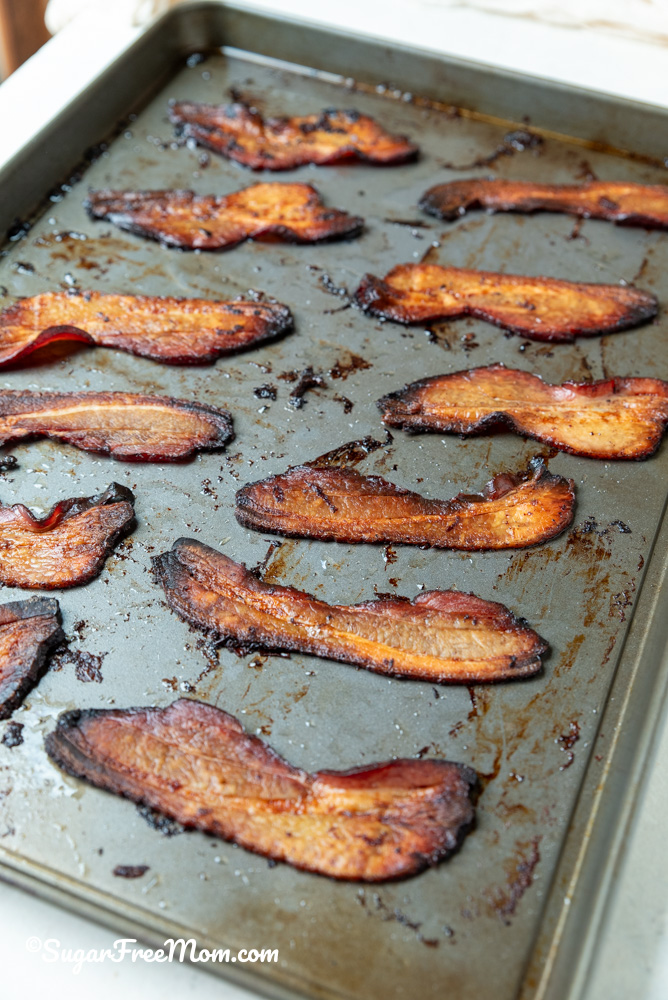
Easy Homemade Bacon Recipe
If you’ve ever picked up bacon at the store and noticed all those sugars and nitrates packed into every bite, you’re not alone in wanting something cleaner and healthier.
Making your own sugar-free, nitrate-free bacon at home might sound like a big deal, but it’s actually super doable and way more satisfying than you’d expect.
Plus, you get to control exactly what goes into it—no funny business. Whether you’re avoiding nitrates for health reasons or cutting sugar out of your life, this recipe has your back with a straightforward approach and tasty results.
Once you master this, you can tinker with flavors and create your own personalized bacon vibe. It really beats anything from a package when you think about it. So go ahead, get cooking, and enjoy bacon exactly how you want it.
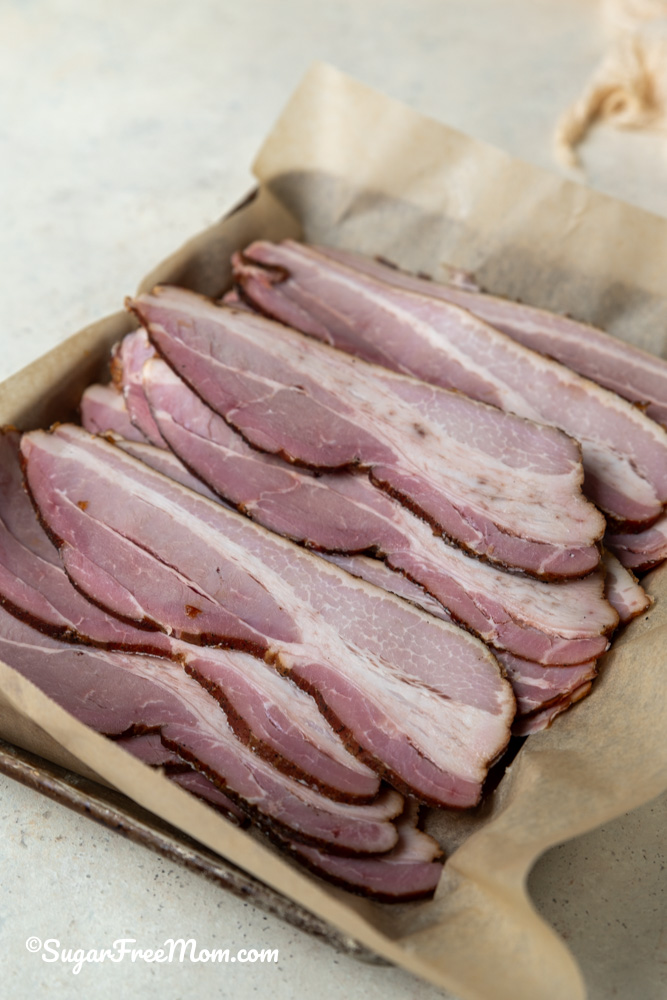
What Makes This Recipe Great
Real control over ingredients.
You can skip all the sneaky sugars and chemical nitrates often found in store-bought regular bacon, making your own bacon free of sodium nitrite and sugars is perfect for folks with dietary needs or simply those who want a cleaner plate.
Knowing exactly what’s in your bacon puts you in the driver’s seat, which is pretty satisfying.
Simplicity meets flavor.
This recipe uses a small amounts of natural ingredients to bring out bacon’s smoky, savory goodness without drowning it in sugar or preservatives. The curing process is straightforward, but the end result is still that rich, mouth-watering flavor you crave.
Customizable and fun to make.
Making bacon at home might seem intimidating, but the process is actually quite simple and you can tweak it to your liking—whether that’s extra smoky, salty, or somewhere in between. It’s a kitchen project that’s more like a fun experiment than a chore.
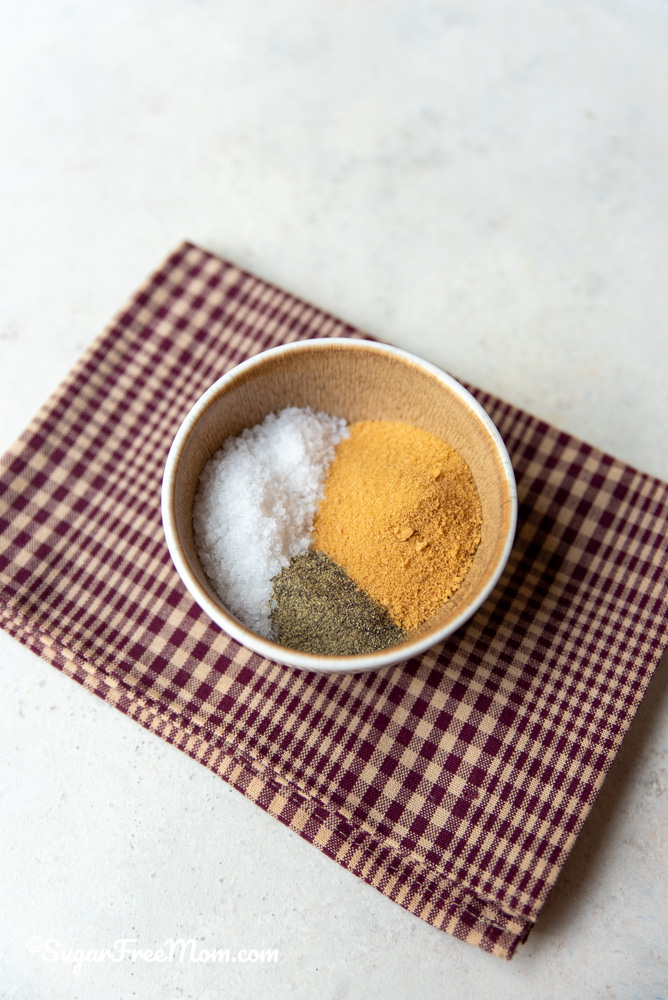
Simple Ingredients and Substitutions
Uncured Pork Belly
This is your go-to cut for homemade bacon since it has the perfect fat-to-meat ratio to get that classic bacon texture. If you can’t find a piece of pork belly, pork shoulder can work, but just know the fat content will be lower, so it won’t be quite as crispy or juicy.
Sea Salt
Salt is the key to curing here, drawing out moisture and preserving the meat. You can use any coarse salt, but avoid iodized salt since it can affect flavor and color during curing.
Curing Salt Substitute
Since we’re avoiding nitrates, you won’t be using traditional pink curing salt. Instead, this recipe relies on sea salt and smoke for preservation and flavor, which means you should keep the bacon refrigerated and use it within a week or so. You can also add celery powder if you want a natural source of nitrates but that’s optional.
Liquid Smoke or Wood Chips
Liquid smoke is an easy way to get that smoky flavor without fancy equipment like a smoker. If you’re feeling adventurous and have a smoker, go for wood chips like hickory or applewood for an authentic vibe.
Spices and Sweetener Substitute
Typical store-bought bacon has sugar, but our sugar-free version we’re leaving it out completely and a low carb brown sugar sweetener for a touch of sweetness. Garlic powder, and paprika can add a cool depth without any extra sugar, but those are optional.
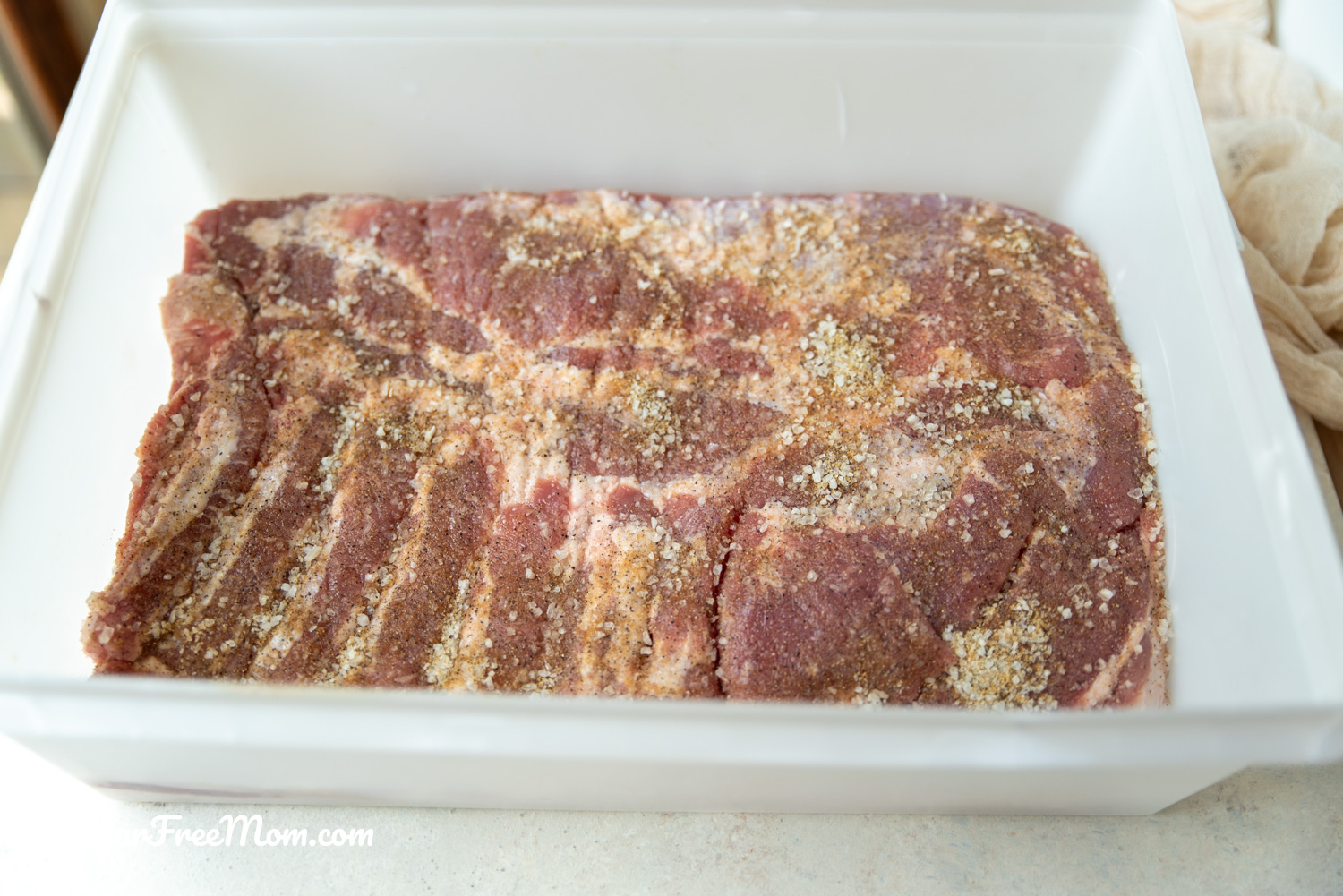
Pro Chef Tips
#1 Use a kitchen scale
Getting the pork belly’s weight is important to calculate the right amount of salt for curing. Too little salt means it won’t cure properly, too much and it can get overwhelmingly salty. We used an 8 pound slab of pork belly. If you can’t find one that big and can only find one half that size, you will need to reduce the salt, pepper and low carb sweetener by half.
#2 Pat dry before curing
Make sure to pat your raw meat pork belly dry with paper towels before you apply the cure mix. Excess moisture can slow down the curing process and prevent the seasonings from sticking well.
#3 Cure in the fridge
Wrap the pork belly tightly and let it dry cure in the fridge for about 5 to 7 days. Check it daily, turning it over to redistribute the cure evenly every 2 days.
#4 Rinse and dry after curing
Once the dry curing is complete, rinse off the salt and spices under cool water, then pat dry thoroughly. Drying it well is key for getting that nice bark during smoking or cooking.
#5 Smoke low and slow
If you have a smoker, aim for around 175°F to 200°F and smoke the pork belly for about 2 to 3 hours until it hits an internal temp of 150°F. This gentle heat helps develop flavor without cooking it too fast.
#6 Or oven method
No smoker? No biggie. After curing, roast it in the oven at 200°F for a couple of hours to mimic that slow smoke effect. You can add liquid smoke to your spice rub for flavor.
#7 Slice cold for neat bacon strips
Chill your bacon after smoking before slicing. Cold bacon slices cleaner and thinner than room temperature, which is perfect for crisping up in the pan.
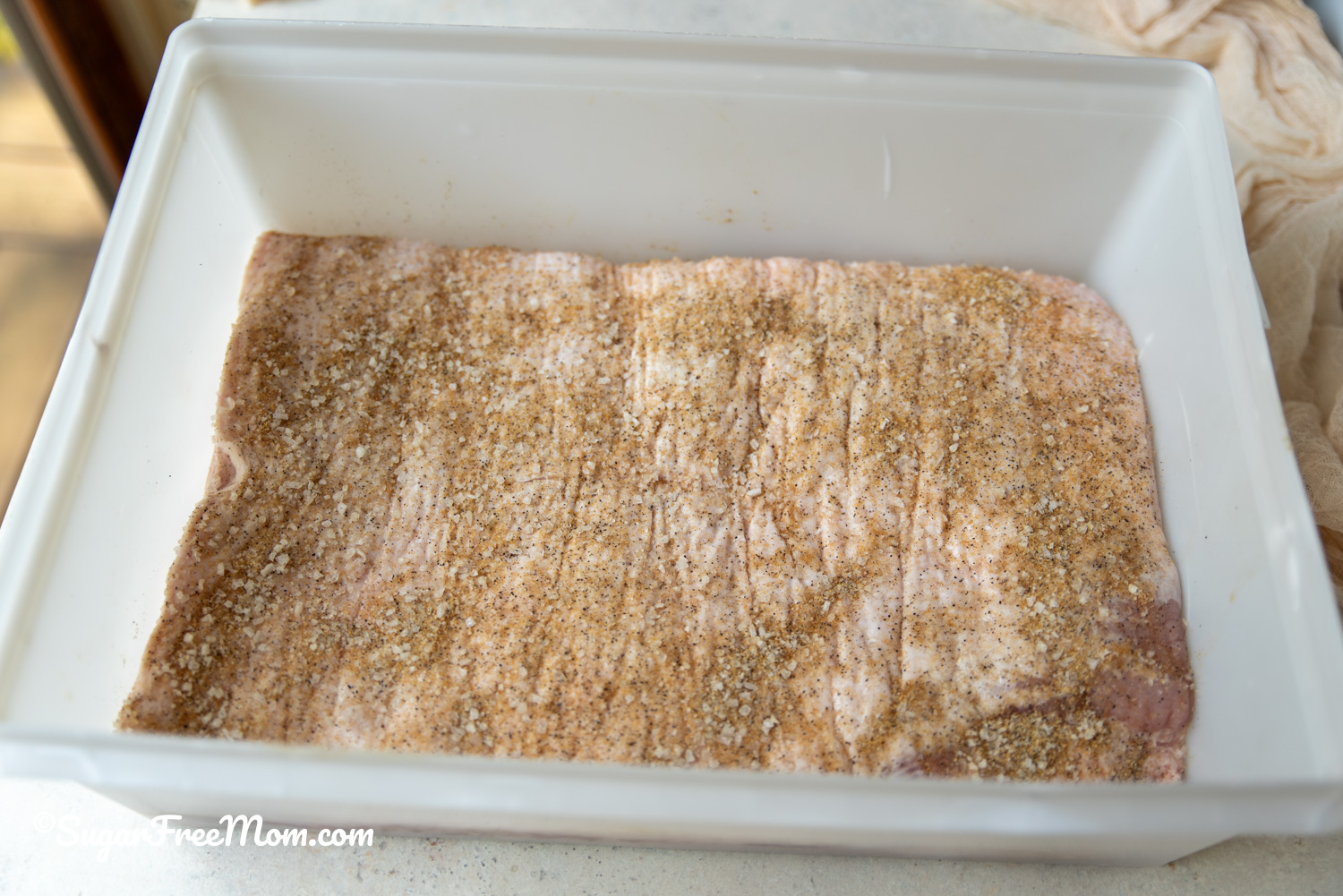
Recipe Variations
Add herbs:
Try tossing in fresh rosemary or thyme during the curing process for a herby twist.
Spice it up:
Throw in cayenne pepper or smoked paprika if you like your bacon with a little heat.
Different smoke flavors:
Experiment with different wood chips like cherry or mesquite for unique smoky profiles.
No smoke option:
Skip smoking and just roast with liquid smoke in the rub for a quick, easier version.
Maple flavor upgrade:
Use a sugar-free maple syrup substitute in the cure for a classic maple bacon vibe without sugar.
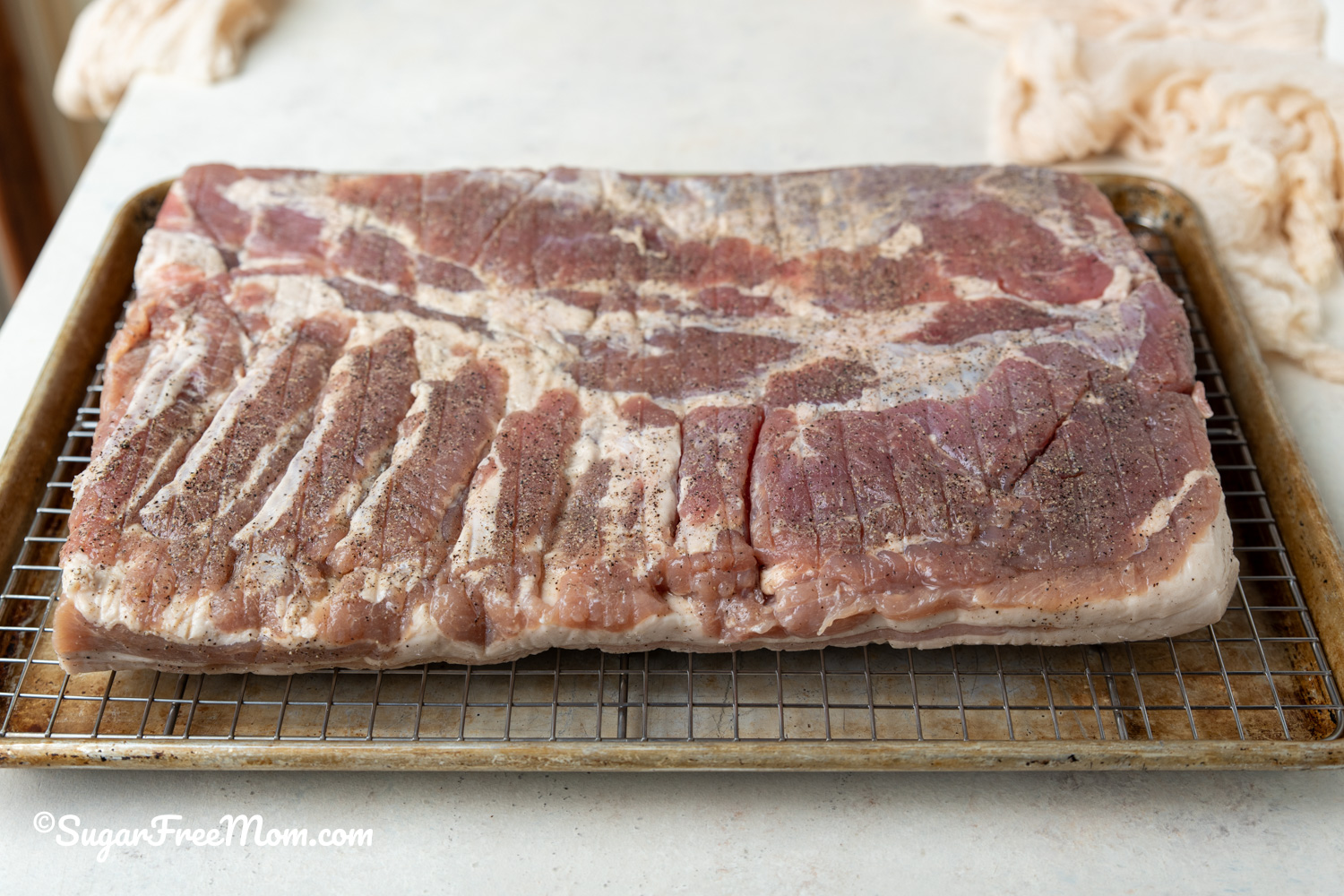
What To Serve With Homemade Bacon
Avocado toast
Creamy avocado pairs super well with bacon’s salty crunch for a simple, satisfying bite.
Eggs any style
Bacon and eggs is a timeless combo for a reason—protein and flavor hitting all the right notes.
Salads
Crispy bacon bits add a smoky, crunchy punch to salads without weighing you down.
Roasted veggies
Serve alongside roasted Brussels sprouts or asparagus for a balanced, tasty plate.
Breakfast bowls
Use your bacon as the star in a wholesome breakfast bowl with grains, greens, and a soft-boiled egg.
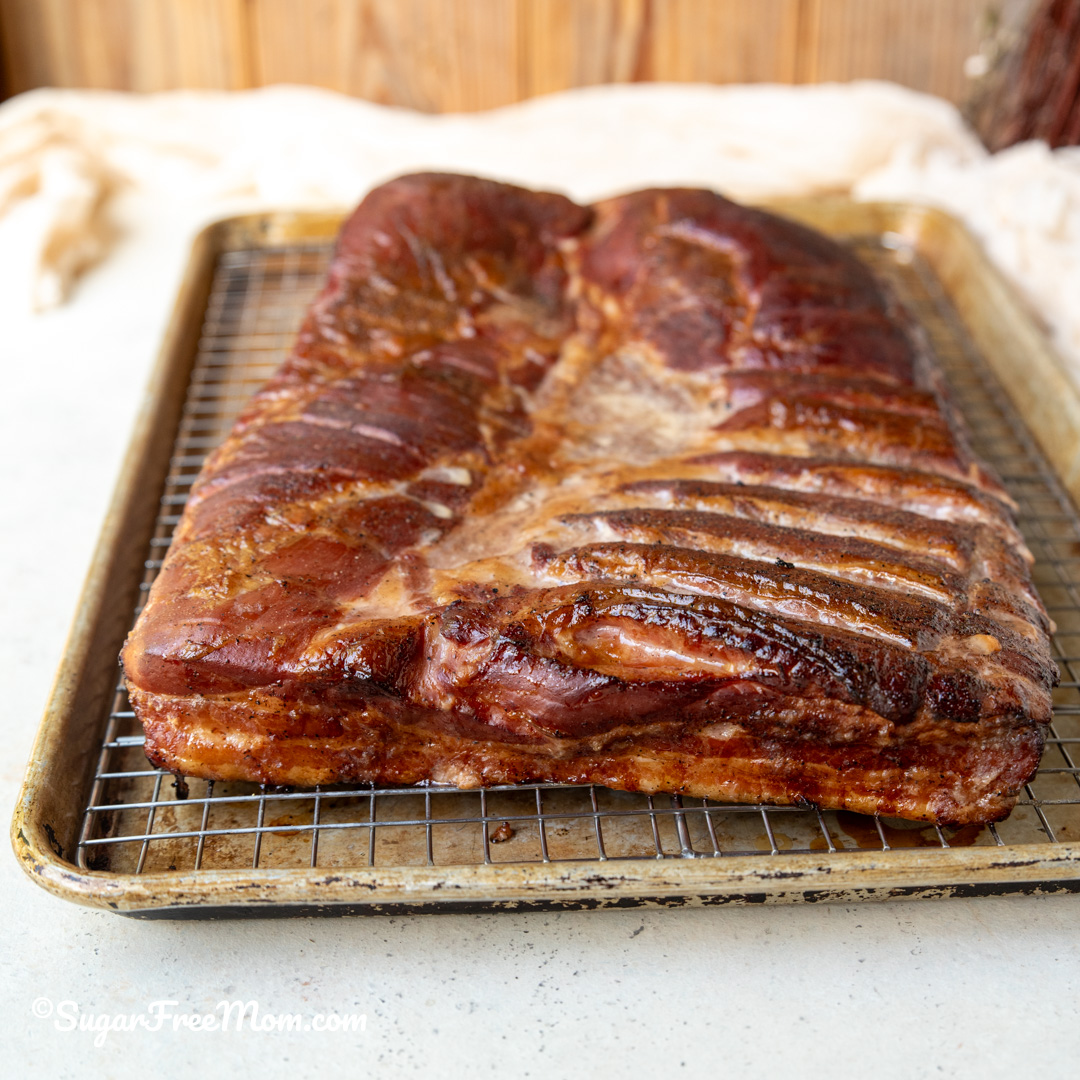
Troubleshooting Common Problems with this Recipe
Bacon too salty
If you accidentally over-salt, soak the pork belly in cold water for a few hours before cooking, changing the water occasionally to draw out excess salt.
Bacon not smoky enough
Make sure your smoker is producing enough clean smoke or add 1 tsp liquid smoke to the rub before cooking to boost flavor.
Bacon too chewy
Thinly slice the bacon after it’s fully smoked and cooled to avoid a rubbery texture. Overcooking can also result in chewiness, so monitor internal temperatures carefully.
Uneven curing
Turn the pork belly regularly during curing and ensure your cure mix is evenly applied on all sides to get consistent flavor.
Meat spoiling during curing
Always cure in the fridge and use fresh, quality pork belly. Don’t cure longer than recommended to avoid spoilage risks.

Freezing & Storing Leftovers
Freezing:
Wrap your cooked bacon that’s come to room temperature tightly in plastic wrap and place in a freezer-safe bag. Freeze for up to 3 months. When ready, thaw overnight in the fridge before reheating.
Storing:
Store cooked bacon in an airtight container or ziplock bag in the fridge for up to 5 days. Keep it crisp by reheating in a skillet or oven instead of the microwave when possible.
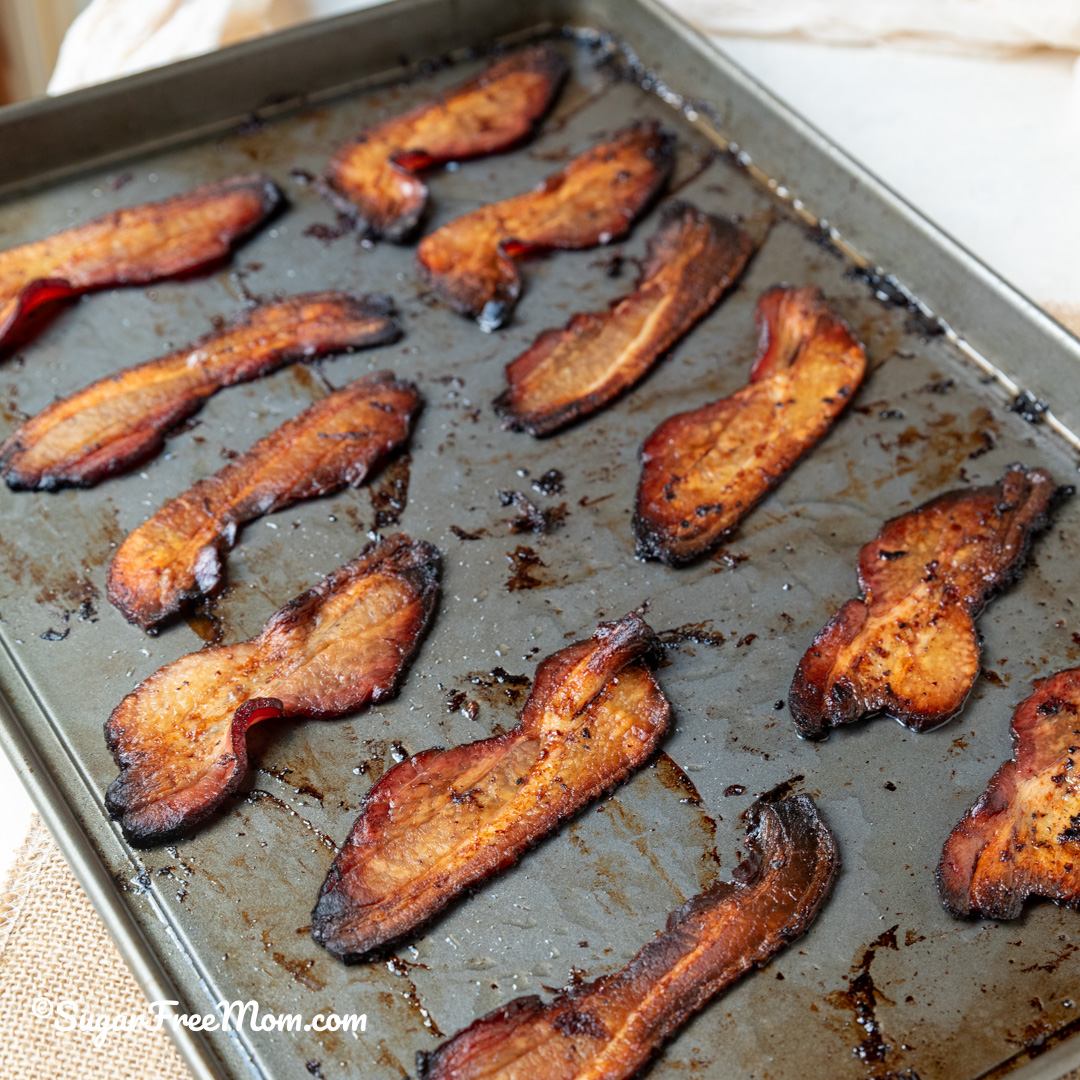
Can I make this bacon without smoking it?
Yes, you can use the oven method with liquid smoke in your spice rub to get that smoky flavor without a smoker.
How long can I keep this bacon once cured?
Since this version skips nitrates, it’s best eaten within 7-10 days if kept refrigerated.
Can I reuse the curing mix?
For best results it’s best to make fresh cure ingredients each time because salt and spices get soaked up and won’t have the same effect.
Does the bacon freeze well before cooking?
Yes, you can freeze the cured pork belly before cooking. Just thaw fully in the fridge before smoking or roasting.
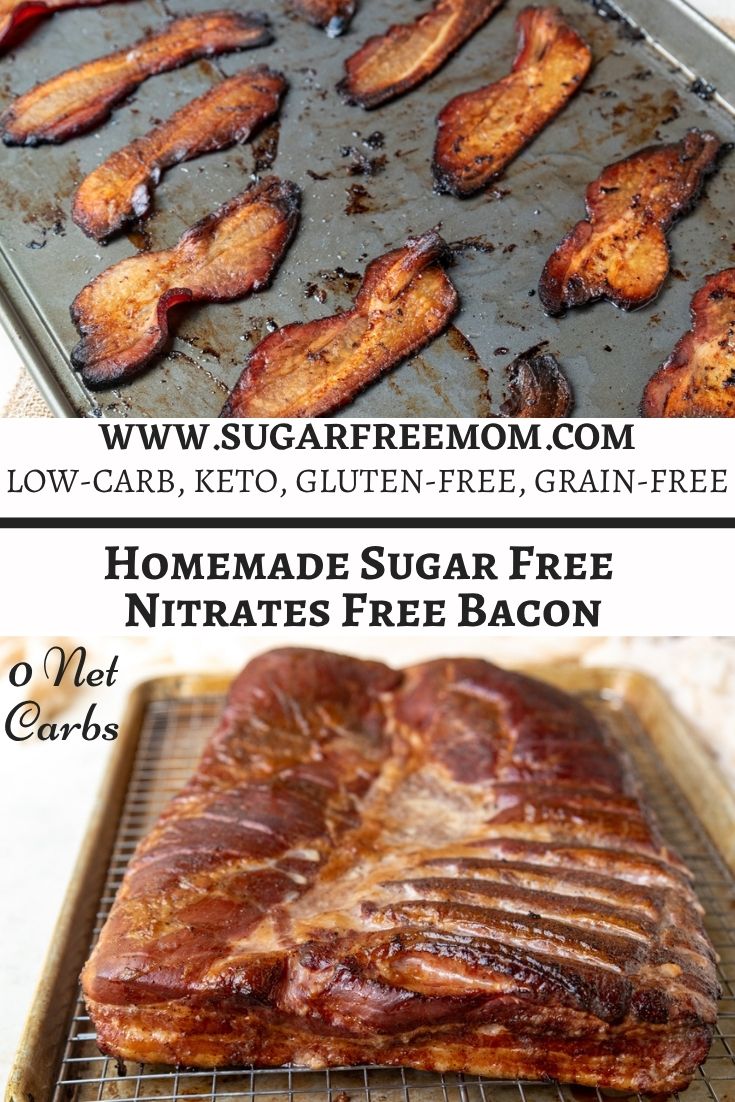
How to Make Homemade Sugar Free Nitrate Free Bacon
How to Make Homemade Sugar Free Nitrates Free Bacon
Equipment
- Meat slicer or sharp knife
- Airtight container
- Smoker or oven
- Meat thermometer
- Cutting board
Ingredients
- 5.2 pounds pork belly We used 8 pounds raw and after cooking is 5.2 pounds
- 8 tbsp sea salt coarse
- 1 tbsp black pepper
- 4 tbsp Monk Fruit Allulose golden sweetener or another low carb brown sugar sub
Instructions
Brine
- If your pork belly still has the skin on it, you will need to remove it. Use a sharp knife to remove skin but leave as much of the fat on the belly as possible.
- Mix salt, pepper and low carb sweetener together in a small bowl.
- Place your pork belly in a deep dish like a turkey roasting pan, rub the dry rub mixture all over the top, bottom and sides of the pork belly.
- Place in the fridge, covered for 7 days, turning the pork belly over every 1-2 days. After 7 days, remove pork belly and rinse under cold running water. Pat dry with paper towels.
- Optional: Place pork belly on a wire rack, uncovered, in the fridge for 7-8 hours. The drier the pork, the better the smoke will "stick" to the bacon.
Smoke in a Smoker
- Preheat your smoker to 180 degrees F. Preheat for at least 5 minutes before placing pork belly in smoker.
- Place pork belly on grill grates in smoker and close lid. Smoke until the internal temperature of the pork belly is 150 degrees F, about 2-3 hours.
Smoke in the Oven
- Preheat oven to 180 degrees F.
- Soak wood chips in water for 4 hours. Line a baking sheet pan with parchment paper. Spread wood chips on paper. Place a wire rack on top of the wood chips and then place pork belly on the rack. Cover with parchment paper.
- Place baking sheet in oven for 2-3 hours until internal temperature reaches 150 degrees F.
Slicing and Storing
- Once bacon has been smoked, allow to cool then refrigerate until you are ready to slice it and store it.
- You should have about a little more than 5 pounds of bacon. Use a meat slicer or slice thinly with a sharp knife. The thickness of the bacon will determine the amount of slices per pound you can yield.For thick cut bacon, slice about a 1/8 inch (3.2mm) thick. You should be able to get 12-14 slices per pound. For thinly slices bacon, slice 1/32 inch (0.8mm) and you should be able to get 16-18 slices per pound.
- Once sliced, store in a gallon ziplock bag, label with date. Refrigerate for up to 7 days or freeze for up to 3 months.
To Bake Bacon
- Preheat oven to 400 degrees F. Place slices onto a large baking sheet pan, do not overlap. Bake for 20 minutes. Remove, drain bacon grease and place bake in the oven for 5 minutes more to get crispy. Alternatively you can fry slices of bacon in smaller batches to fit in a frying pan and cook until crisp.
How to Reheat
- Oven Method- Preheat your oven to 350°F (175°C). Layer bacon on a baking sheet lined with parchment and heat for about 10 minutes, flipping halfway through. This way it stays crispy without getting rubbery.Skillet Method- Warm a non-stick skillet over medium heat and cook bacon slices for a couple of minutes on each side. This method helps keep the crisp texture and heats evenly.Air Fryer Method-Pop the bacon in an air fryer for 5 minutes at 350°F for quick reheating that keeps the crisp without drying it out.
Notes
- At 18 slices per pound, you get:
- 5.2 lbs × 18 slices/lb = ~94 slices total
Total servings:
- At 2 slices per serving → ~47 servings







love the idea of making sugar-free, nitrate-free bacon at home. It’s a great reminder that homemade food can be just as flavorful—if not more—than store-bought options, while giving you control over the ingredients. This recipe seems perfect for anyone looking to eat cleaner without giving up taste.